The Intel SSD 540s (480GB) Review
by Billy Tallis on June 23, 2016 9:00 AM ESTMixed Random Read/Write Performance
The mixed random I/O benchmark starts with a pure read test and gradually increases the proportion of writes, finishing with pure writes. The queue depth is 3 for the entire test and each subtest lasts for 3 minutes, for a total test duration of 18 minutes. As with the pure random write test, this test is restricted to a 16GB span of the drive, which is empty save for the 16GB test file.
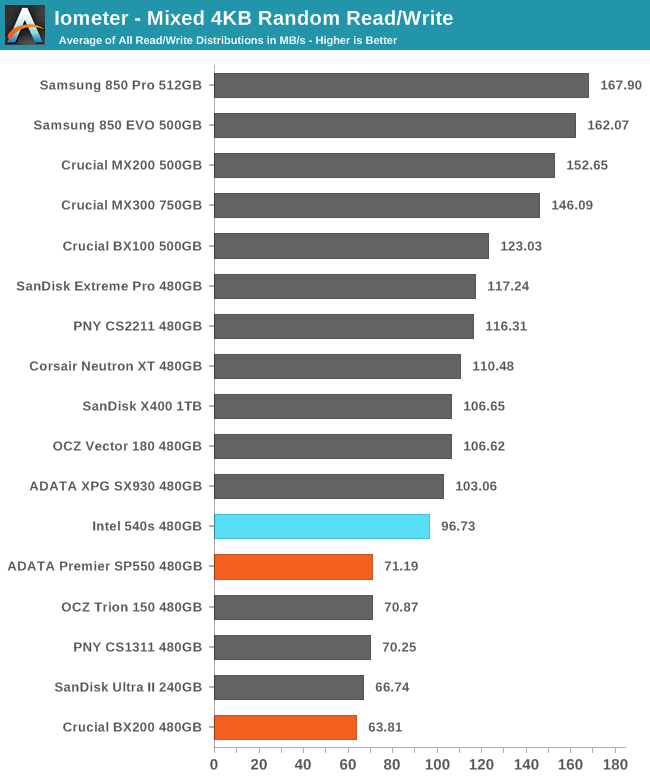
On the mixed random I/O test the Intel 540s has a stark advantage over almost all other planar TLC drives, and is close to the low-end MLC drives and SanDisk X400.
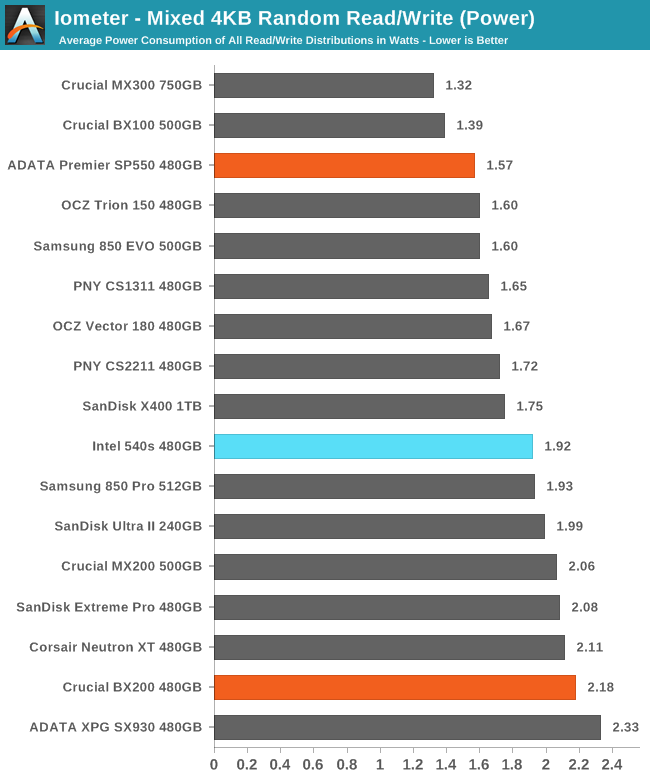
Power consumption is middle of the road, so the Intel 540s comes out at ahead of most of the TLC drives in terms of efficiency, though the SP550 is not far behind.
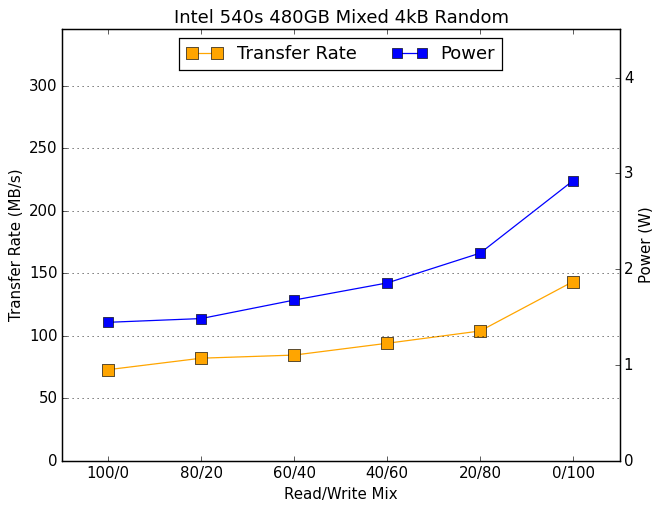 |
|||||||||
The performance of the Intel 540s never dropped as the proportion of writes in the workload increased, but it also didn't show the common big jump in performance during the final pure-write phase of the test.
Mixed Sequential Read/Write Performance
The mixed sequential access test covers the entire span of the drive and uses a queue depth of one. It starts with a pure read test and gradually increases the proportion of writes, finishing with pure writes. Each subtest lasts for 3 minutes, for a total test duration of 18 minutes. The drive is filled before the test starts.
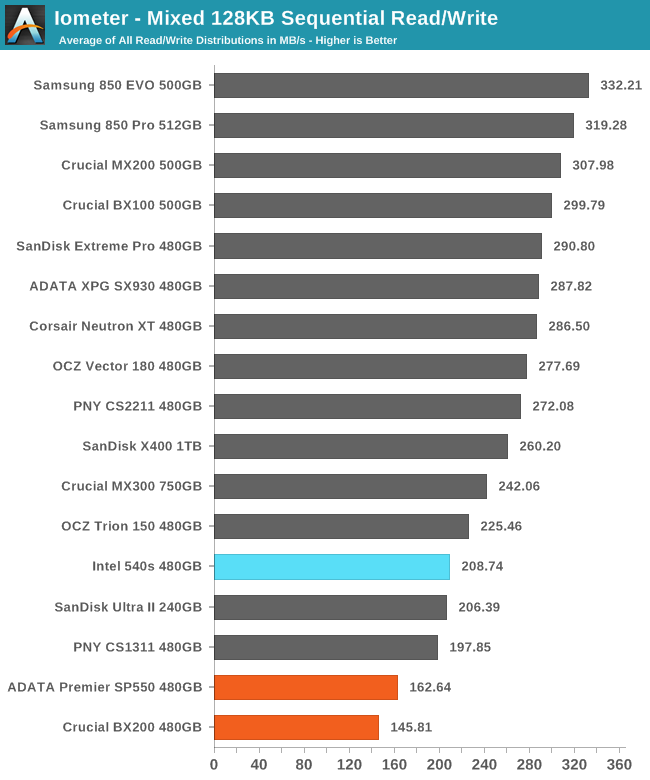
The mixed sequential I/O performance of the Intel 540s is significantly improved over the SM2256 drives, but that still only brings it up to par for planar TLC.
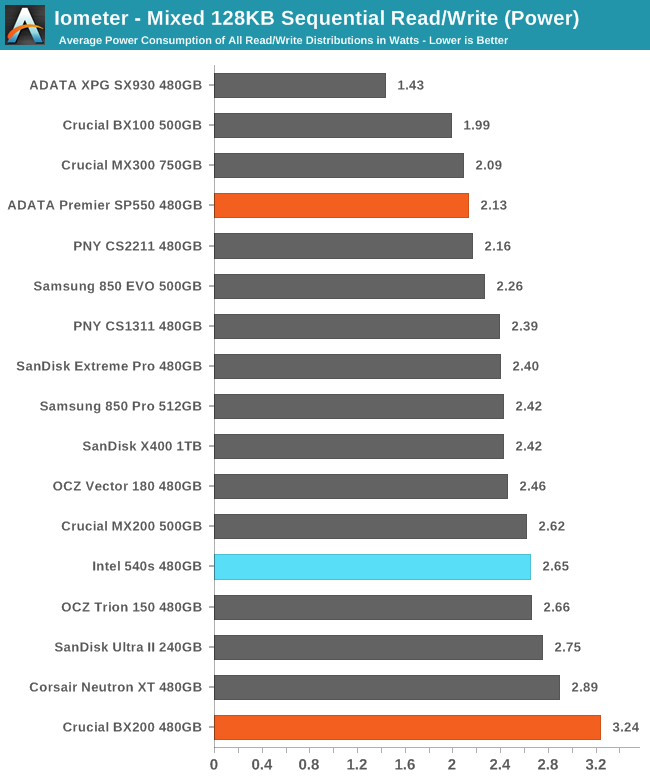
The power usage of the Intel 540s is relatively high, so it doesn't have great efficiency even by TLC standards.
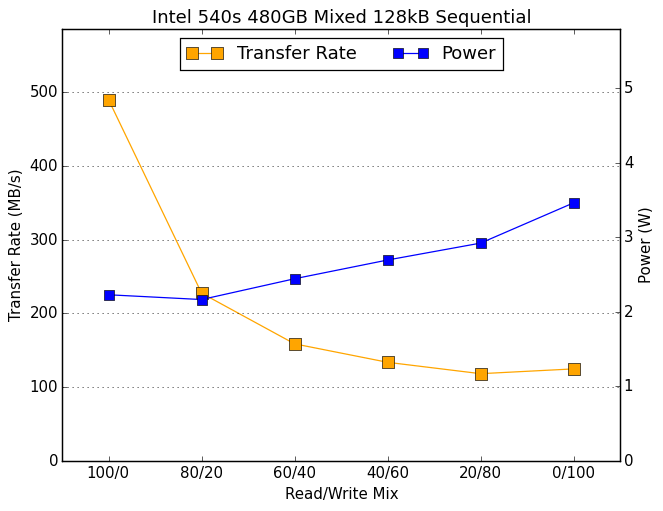 |
|||||||||
The Intel 540s is both faster and more power hungry than the SP550 at every point during this test. Performance still doesn't bounce back appreciably with the pure writes phase of the test, which keeps the average down despite the good read performance at the beginning.










77 Comments
View All Comments
Notmyusualid - Thursday, June 23, 2016 - link
Ya saved me from writing it...shelbystripes - Thursday, June 23, 2016 - link
Intel is considered a reliable brand to OEM PC makers and other bulk purchasers. Offering a low-end part means capturing business that might go to a second-tier manufacturer. For builders with a use case where any modern SSD is fast enough, and you care about reliability without breaking the bank, this will be the #1 choice. You get the Intel name and the things INCLUDED with that, like solid customer support and timely firmware updates, at a lower price point.Nobody buying this is expecting it to be a performance part. Intel is the company that sold Celerons with no L2 cache, that sells cut-down Atom CPUs and Core CPUs under the same Pentium brand name. Intel doesn't always mean performance. It does mean confidence that what you're buying actually works, though.
BurntMyBacon - Friday, June 24, 2016 - link
@shelbystripes: "Offering a low-end part means capturing business that might go to a second-tier manufacturer. For builders with a use case where any modern SSD is fast enough, and you care about reliability without breaking the bank, this will be the #1 choice."You know, Intel used to cater to this market, ... , with their 300 series drives. Interestingly, the relative performance of this drive matches up to where their 300 series used to slot in as well. Why is this not a 300 series drive?
vladx - Friday, June 24, 2016 - link
My tablet running an Atom quad-core works great. To compare this joke of a SSD from Intel to that is a fucking joke.plopke - Thursday, June 23, 2016 - link
Won't the 540 be shortlived? Shouldn't we be seeing 3d nand drives of intel soon followed by optane?https://i0.wp.com/benchlife.info/wp-content/upload...
A5 - Thursday, June 23, 2016 - link
This is for a different market segment.Billy Tallis - Thursday, June 23, 2016 - link
That roadmap shows the 540s sticking around at least through Q1 2017, and merely being joined by some Optane and 3D TLC NVMe drives. The actual replacement of the 540s is at an indefinite point in the future.The determining factor will be how long it takes 3D NAND to get cheap enough to displace 15/16nm TLC. I don't think that will be happening any time soon; even Samsung apparently can't pull it off yet, since they introduced the 750 EVO.
Mobile-Dom - Thursday, June 23, 2016 - link
IIRC Samsung used planar NAND in the 750 because they wanted lower capacity without the performance degradation, as by using the high layered 3D NAND they used fewer packages resulting in worse performance for drives that had 1 or 2 packages for the entire SSDextide - Thursday, June 23, 2016 - link
Nah, both their planar 15/16nm and their 3D NAND use 128Gb dies -- so same amount of dies in either product. It's purely a cost thing. It will probably take until we get into the 100+ layers of 3D NAND for it to be competitive, cost wise, with that 15/16nm planar TLC.Billy Tallis - Thursday, June 23, 2016 - link
That's what they said at first, but then they introduced a 500GB 750 EVO while the 850 EVOs on the market are still using the 32-layer VNAND.